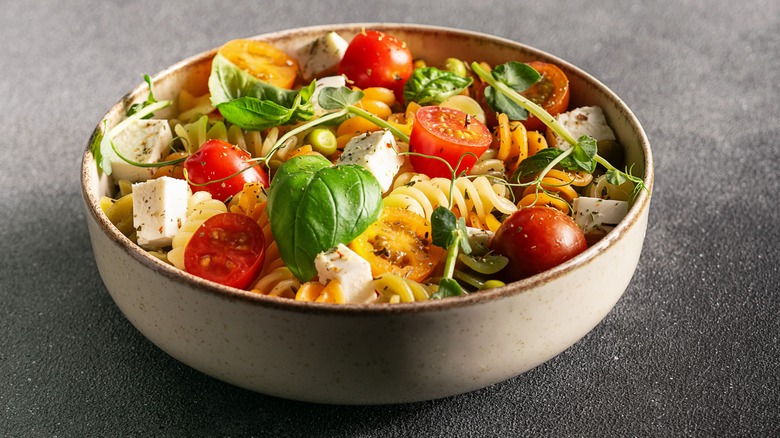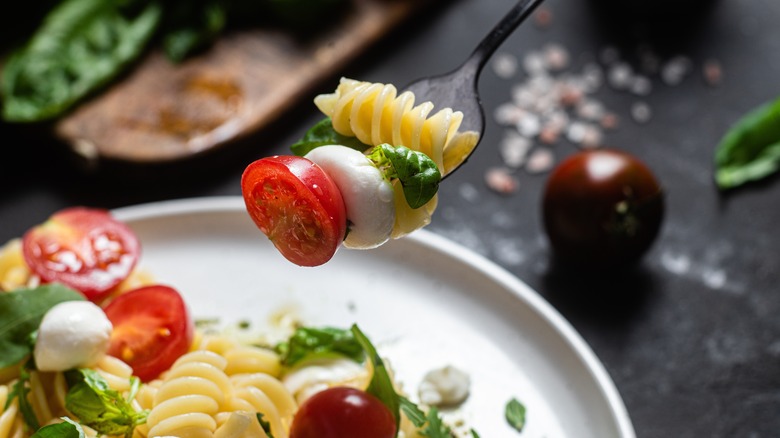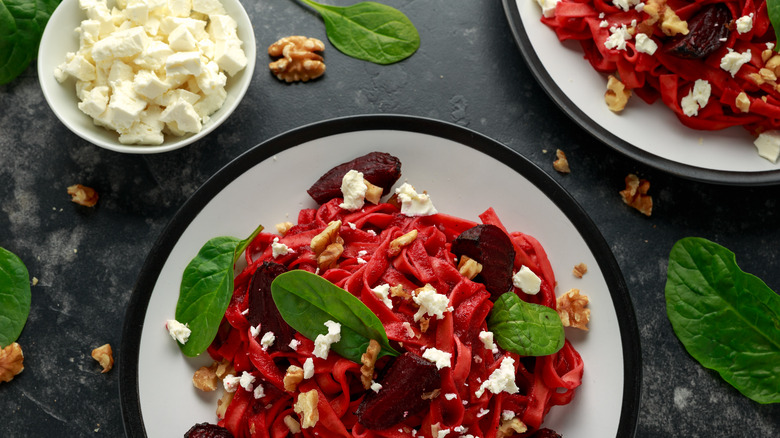The Best Type Of Cheeses To Add To Your Summer Pasta Salad
Pasta salads are a great way to fix your pasta craving and sneak some fresh vegetables in as well. While often relegated to side-dish status, a pasta salad can be as hearty as a cooked pasta dish. Cheese gives your pasta salad heft and a healthy boost in protein. Most importantly, it forms the rich umami bridge that connects delicious starchy pasta with the dish's bright salad ingredients.
There are several mistakes to watch out for when building a pasta salad. One of the most important aspects to consider is balancing the ingredients so that they complement each other and no single ingredient overpowers the others. Cheese is a particularly potent component, and its presence (or absence) can make or break a dish. With the incredible variety of fromage available, picking the right one for your pasta salad is crucial. In addition to its tasting notes and aromas, the cheese's texture and even how it is incorporated — whether in cubes, slivers, grated, or softened — need to be considered.
To be clear, just because a salad contains pasta doesn't mean that it must contain cheese. There are lots of great pasta salads without cheese that draw creaminess from the starch-olive oil emulsion that forms as you mix the pasta and salad dressing. However, there's always a cheese loophole, so if you play your culinary cards right, you can usually sneak in some cheese and elevate the salad without detracting from its character.
How to pair cheese with pasta salad ingredients
A summer pasta salad is an explosion of fresh flavors and textures and a trip to the farmer's market can inspire you to make a dozen different kinds of salads. Let's start with pasta salad staples — the Caprese and the pesto pasta salad. Both rely heavily on basil and, to a lesser extent in the latter, tomatoes. However, both salads have opposing characteristics and, therefore, use very different cheeses.
Apart from the pasta, a Caprese contains only three main ingredients — tomatoes, basil, and mozzarella cheese. All three are meant to be fresh, making this is lightly flavored salad with no deep, cooked flavors. The creamy, mildly flavored fresh mozzarella complements and balances the basil's sharpness and the tomato's sweet sourness without overwhelming either. In most cases, the cheese will contrast the salad's other ingredients. A pesto pasta salad, made with basil and raw garlic, has punchier, sharper flavors and therefore benefits from the deep, nutty notes of aged parmesan cheese.
The third popular cheese that works well in pasta salads is feta, especially if your dish has Mediterranean flavors from olives, bell peppers, and red onion. Both Greek and watermelon pasta salads (often made with orzo) benefit from the briny, tangy notes of feta cheese which can be either creamy or crumbly. The cheese is bold enough to work with strong flavors, and can therefore contrast just as well with sweet watermelon as with spicy, raw onion.
Try these cheeses in your next summer pasta salad
While the three aforementioned cheeses pair well with specific pasta salads, it's a good idea to widen your repertoire to include a few more. Fresh goat cheese (sometimes called chèvre) has a distinct tangy flavor and its texture is right on the edge of gooey. You can soften it like cream cheese, spread it on a plate and arrange your pasta salad on top, or crumble it in soft chunks over the salad. Its flavor complexity and creaminess make goat cheese a great addition to a wide variety of dishes, from simple green salads to more complex ones that combine sweet and savory elements. Think kale and cranberry, or any pasta salad with a honey mustard dressing.
For the adventurous palette, look no further than blue cheese. Despite being classified as a stinky cheese due to its pungency, the distinctive sharp flavor and creaminess work very well when used in controlled amounts. Blue cheese salad dressing is a good place to start if you're not sure whether you'll like it, but crumble some of the real stuff on a pasta salad and the flavor will grow on you. Blue cheese is surprisingly versatile and works well with spicy, savory, and sweet flavors. A simple pasta salad with herbs, greens, and tomatoes will benefit from it, as will a more complex one made with, say, arugula, apples, and candied walnuts.


